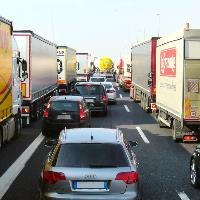(BRUSSELS) – The EU Commission proposed measures Tuesday to make freight transport more efficient and more sustainable, improving rail infrastructure management with incentives for low-emission lorries.
Freight is responsible for over 30% of transport CO2 emissions, and this is likely to rise without action, with freight transport expected to grow by around 25% by 2030, and 50% by 2050.
The aim is to increase efficiency within the sector, helping it to contribute to the target of cutting transport emissions by 90% by 2050, while allowing the EU single market to continue growing.
With rail tracks being expensive to build and increasingly congested, the proposed Regulation will optimise their use, improve cross-border coordination, increase punctuality and reliability, and ultimately attract more freight companies to rail. Passengers will benefit from additional rail services as the capacity of the network will be better used, impacting positively the cross-border services by enabling more frequent connections and earlier ticket booking, among others.
Current rules on capacity management are decided annually, nationally and manually. This does not favour cross-border traffic (around 50% of rail freight crosses borders); the fractured approach leads to delays at borders. This, in turn, hinders the functioning of the Single Market. Delays due to congestion caused by uncoordinated maintenance work are also common.
More than 50% of freight is carried by road in the EU (2020 figures), and this transport is a major contributor to greenhouse gas emissions. The current Weights and Dimensions Directive sets the maximum weight length, width and height for heavy-duty vehicles. Today’s proposal revises these rules to allow additional weight for vehicles using zero-emission technologies, as they tend to increase a vehicle’s weight. This will incentivise the take-up of cleaner vehicles and technologies. Once the technology develops and and zero-emission propulsion systems become lighter, thanks also to the use of aerodynamic devices and cabs, cleaner vehicles will benefit from additional loading payload in comparison to conventional lorries.
The uptake of more aerodynamic cabins and other energy-saving devices will also be encouraged, not only improving driver comfort and safety, but also increasing the efficiency of zero-emission powertrains meaning the mechanism that transmits the power from the engine to move the vehicle.
The proposal will also provide clarity on the use in cross-border traffic, in certain conditions, of heavier and longer vehicles, which are allowed today in some Member States. This includes clarifying that Member Stated who allow European Modular Systems (EMS) in their territories, will also be able to use them in international operations among these neighboring Member States, without a need for a bilateral agreement and without a restriction of crossing only one border. This will mean the same amount of cargo can be carried in fewer trips.
To encourage intermodal transport, whereby goods are moved using two or more transport modes but with a standardised cargo unit (like a container trailer or other), lorries, trailers and semitrailers will be allowed to carry extra weight. Extra height will also facilitate the transport of high-cube containers by standard vehicles.
The Commission is proposing a common methodological approach for companies to calculate their greenhouse gas emissions if they choose to publish this information, or if they are asked to share it for contractual reasons. The proposed methodology is based on the recently adopted ISO/CEN standard for the quantification and reporting of greenhouse gas emissions arising from the operation of transport chains of passengers and freight. Reliable data on door-to-door emissions will enable operators to benchmark their services and allow consumers to make informed choices on transport and delivery options.
New measures to better manage and coordinate European rail traffic - guide



